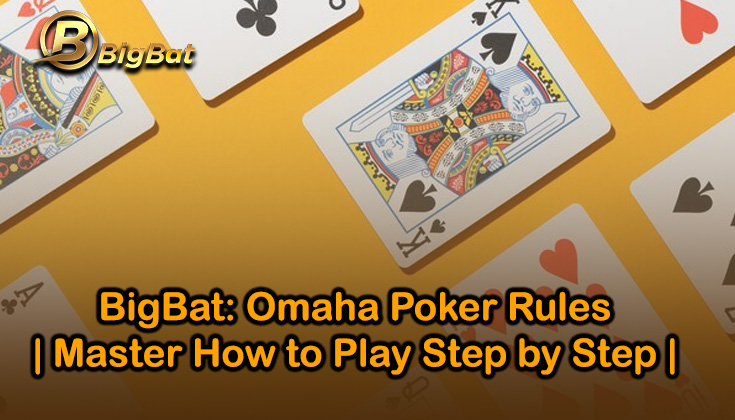Omaha Poker Rule | Bigbat Omaha Guide | How to Play Omaha | Bigbat Casino Omaha Rules
Omaha poker is a thrilling variation of poker that offers exciting challenges for players seeking to refine their skills. The Omaha poker rule requires a strategic approach, as players must use exactly two hole cards and three community cards to form the best five-card hand. In this Bigbat Omaha guide, we’ll walk you through the essentials of how to play Omaha and share insights into Omaha rules to ensure you master the game with ease. Start Game
What is Omaha Poker?
Omaha poker is an exciting and fast-paced variant of poker, but with a unique twist. In Omaha poker, each player receives four private cards, known as ‘hole cards’, instead of the two in Texas Hold’em. The game also features five community cards that all players share. To form the best possible hand, you must combine exactly two of your hole cards with three of the community cards. This specific combination rule is a key part of the Omaha poker rule. Understanding how to play Omaha and adhering to these rules increases your chances of winning in a fast-paced environment.
Types of Omaha Poker Games
There are several variations of Omaha poker, each with different betting structures, but the basic gameplay remains similar. Here’s a quick breakdown:
- Pot Limit Omaha (PLO): In Pot Limit Omaha, players can bet up to the size of the current pot. For example, if the pot contains $100, the maximum bet is $100. This variation is one of the most popular types of Omaha.
- No Limit Omaha: In this variant, players can bet any amount including going all-in at any point during the game. This version of Omaha adds an extra layer of excitement.
- Fixed Limit Omaha: The fixed limit version of Omaha places a cap on how much a player can bet during each betting round. This can lead to more controlled play and less aggressive betting.
The Blinds and Dealer Button
Much like Texas Hold’em, Omaha poker uses a dealer button to determine the order of play. The button moves clockwise to the next player after each hand. Before cards are dealt, two mandatory bets are made:
- Small Blind: The player to the left of the dealer places the small blind which is usually half of the table’s betting stakes. For instance, if the table is set at $1/$2, the small blind would be $1.
- Big Blind: The player sitting to the left of the small blind places the big blind which is typically equal to the larger betting stake. In a $1/$2 game, the big blind would be $2.
How to Play Omaha Poker?
Pre-flop: After being dealt their hole cards, players decide whether to call or raise the big blind. The action starts with the player to the left of the big blind and continues clockwise. The betting round continues until all players still in the game have contributed an equal amount to the pot.
Flop: The dealer places three community cards face-up on the board. This is known as the flop and players can use these cards along with their hole cards to form the best five-card hand. A new betting round begins after the flop.
Turn: The dealer adds the fourth community card, called the turn, to the board. Another round of betting follows, starting with the player to the left of the dealer button.
River: The final community card, known as the river, is dealt face-up. A final betting round follows where players have the opportunity to make their best hand with the five community cards and their hole cards.
Showdown: If more than one player remains after the final betting round, the showdown occurs. Players reveal their hole cards and the player with the best five-card hand wins the pot. In Omaha poker, players must use exactly two of their hole cards combined with three of the community cards.
Differences Between Omaha and Texas Hold’em
While Omaha poker shares many similarities with Texas Hold’em, the key difference lies in the number of hole cards dealt to each player and how those cards are used. In Texas Hold’em, players can use any combination of hole cards and community cards to form their best hand. However, in Omaha, players are required to use exactly two hole cards and three community cards which significantly impacts hand potential and strategy. This difference in hand construction makes Omaha a more complex and strategic game as the Omaha poker rule gives players more opportunities to form stronger hands.
Conclusion
Whether you’re new to the game or looking to refine your strategy, this Bigbat Omaha guide provides the key insights into how to play Omaha effectively. By following the Omaha poker rule and understanding the various betting structures, you’ll increase your chances of making better decisions at the table. Keep in mind that the Omaha rules may vary slightly, but the core mechanics remain the same across all variants. Embrace the challenge and soon you’ll be mastering Omaha poker like a pro!






























